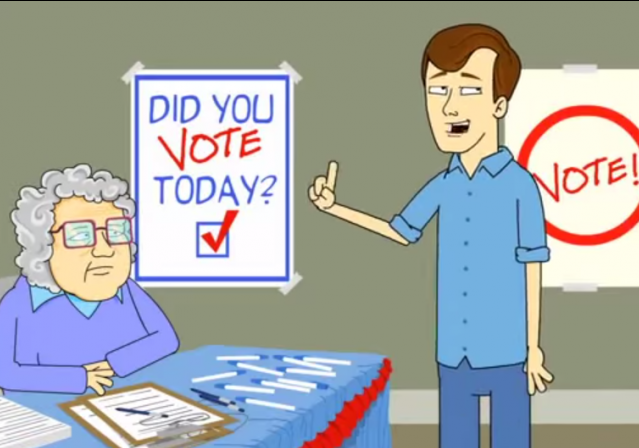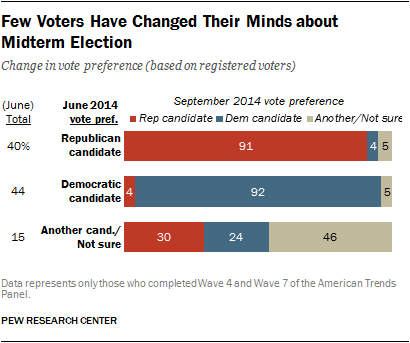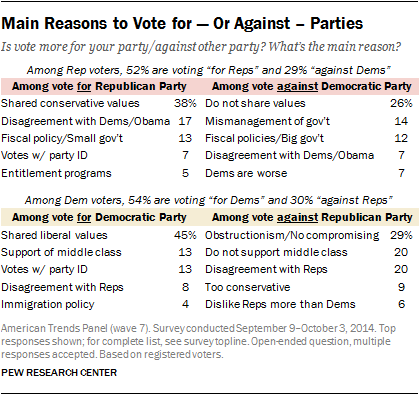GOTV: Pew finds likely voters not likely to change allegiance
Focus on independents, emphasize straight ticket voting.

A new data dump from Pew Research suggests that political campaigns might want to abandon any last-ditch efforts to change minds prior to this year’s midterm elections.
A continuous panel survey of 3,154 adults showed that this years likely voter demographic is more polarized than the average American. This polarization also affects level of involvement in local and national politics: the more ideologically oriented the voter, the more likely they are to be politically active.
Only 40% of the population is expected to participate in the November midterms, but those who do plan on voting won’t necessarily be checking the box because they believe in the power of democracy. Pew found a strong correlation between ideological polarization, and voting as a way to hit back at the opposing party.
Hostility to the opposing party is a key marker of polarization and is a strong motivator to vote, especially among conservatives and Republicans. Ideology and partisan antipathy are related: Those holding ideologically consistent opinions are far more likely than others to view the opposing party negatively, and even to view it as a threat to the nation’s well-being.
Among Republicans and Republican leaners with a very unfavorable view of the Democratic Party in the current survey, 65% are likely voters, compared with only 49% among Democrats with a very unfavorable view of the Republican Party. Those who are less hostile to the opposite party are considerably less likely to vote. Among Republicans, 40% of those with a mostly unfavorable view of Democrats are likely to vote, and only 23% of those with positive views (or who offer no opinion) of the Democratic Party are likely to vote. On the other side, 33% of Democrats with a mostly unfavorable view of the Republican Party are forecasted to turn out, as are 19% of those with positive views of (or no opinion about) the GOP.
In addition to being polarized, both Republican and Democrat voters remained loyal to their party as the midterm cycle progressed. 91% of Republicans and 92% of Democrats have remained ideologically consistent, and haven’t changed their minds regarding which candidate they plan on voting for in November.
Who has had a change of heart? Independents have—and they’re trending Republican.
This is where the money is, and where Republicans need to be focusing in the last days before the election. Voters who either aren’t sure, or have changed their mind once before, are the low hanging fruit we need to win local level elections.
If you need a stick to knock it down, drop the stick and move on. We don’t have time for policy battles.
In addition to focusing on undecided voters, we also need to push the idea of actually voting a straight ticket. Local elections are won and lost at the bottom of the ballot, and now is the time for Republicans to take those seats back:
An analysis of voters living in areas with two or three major political contests this November shows that only 12% of registered voters say they are splitting their vote between multiple political parties. About three-quarters of registered voters (74%) in these areas say they will select candidates from the same party for all major political races in their area, known as “straight ticket” voting.
When narrowed to those most likely to vote in the November election, about eight-in-ten voters (81%) choose a straight party ticket. They are slightly more likely to select only Republican candidates than only Democratic candidates (43% to 36%).
What’s the takeaway?
Get into these communities and ask for these votes. 65% of independents are willing to vote straight ticket, and independents are more likely to vote straight Republican than straight Democrat. Hard Democrats aren’t going to change their minds, but an independent might swing right if you show her how progressive policies have raised her taxes, made her health care choices more complicated, and turned the local schools into automaton breeding grounds.
If you’re at a loss for material (which should be impossible considering how laughably awful progressive policies are,) use this handy chart (also from Pew) as a guide:
Some races may already be decided, but there are plenty of conservatives in battleground districts who will still be knocking on doors come November 4. They’re using data like this to target voters they know they can get.
Don’t write off 2014 because of the mistakes the GOP has made in the past. We have 19 days to get it right for 2014, and two years to work for a win in 2016.
It’s not much time, but it’s enough.
Featured Image College Humor Video
 DONATE
DONATE
Donations tax deductible
to the full extent allowed by law.










Comments
Well, it’s ALSO true that a lot of us CONSERVATIVES are identifying as independents now.
Some of us have for decades, a lot more just recently.
Why? Mississippi would give you a very good start…
Remember in some states you are forced to “register” as one party or another.
Otherwise you get ZERO vote in the primaries – and only get to vote in the Final Novermber general election.
Hell, in 2008 I VOTED AND CAUCUSED in the Texas primary as a Deemocrat because…chaos…!!!
Of course the Democrat column adds up to 101%.
102.673 % in Minnesota. You forgot about Minnesota car trunks, those strange ones that like to hold onto voters’ ballots till the last minute.
Better audit that.
I got 133%!
Snark
” Democrats with a mostly unfavorable view of the Republican Party are forecasted to turn out, as are 19% of those with positive views of (or no opinion about) the GOP.”
I doubt that 19% actually exists.
Since when has PEW been reputable?
I’m asking……..
Thing to keep in mind though is that the acclaimed Dem GOTV apparatus that won Obama reelection goes after ultra-low information, minimally motivated, voters. Things like texting them every hour on their govt supplied ObamaPhones until they vote, pushing the voter’s hot button issue. Ever wonder why they are so insistent on Election Day registration, and not requiring a p hoot ID? This is part of it – a lot of these people don’t plan ahead to vote, but are rather hectored into it at the last minute.
Slice baloney thin enough and its transparent. Slice a diamond thin enough and it’s just pencil lead graphite. But it’s hard to slice diamonds, baloney is easy. In any case this is analysis made of slices too thin.